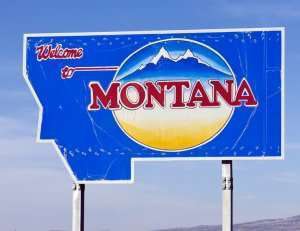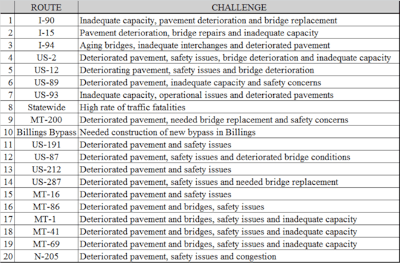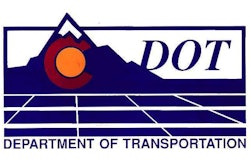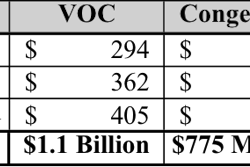
According to the report, “Montana’s Top 20 Transportation Challenges and the Improvements Needed to Address them,” the improvements needed to address these transportation challenges will cost approximately $7.4 billion. However, at this time, funding is only available for $1.2 billion in needed improvements on these corridors, leaving a backlog of nearly $6.2 billion in needed improvements and upgrades.
The following graphic shows Montana’s top transportation challenges. Further details about each challenge can be found in the TRIP report and appendix.
 Top transportation challenges in Montana.
Top transportation challenges in Montana.Follow us on Facebook and Twitter!
“The Montana Chamber knows how important a good infrastructure system is to a strong economy and long-term prosperity,” said Webb Brown, president and CEO of the Montana Chamber of Commerce. “To have that good system, we must have stable, dependable funding to ensure it.”
According to the TRIP report, in 2012, 29 percent of Montana’s major state and locally maintained urban roads were in poor condition, 37 percent were in mediocre or fair condition, and 33 percent were in good condition. Six percent of Montana’s state and locally maintained rural roads were rated in poor condition in 2012, while 35 percent were rated in mediocre or fair condition and 59 percent were rated in good condition.
“With Montana’s public infrastructure so vital to our health, safety, quality of life, and economic vitality, it is critical that all residents be informed regarding its current conditions so appropriate stewardship can be administered,” said Bill Wiegand, president of the American Society of Civil Engineers (ASCE) – Montana Section.
In 2013, seven percent of Montana’s bridges were rated structurally deficient by the TRIP report while an additional 10 percent of Montana’s bridges were rated as functionally obsolete.
Related Read:
Bad roads cost Massachusetts drivers $8.3 billion a year
Reducing the state’s fatality rate was identified as the eighth most critical transportation challenge. Currently Montana’s traffic fatality rate is among the highest in the nation. Montana’s overall traffic fatality rate of 1.72 fatalities per 100 million vehicle miles of travel in 2012 is significantly higher than the national average of 1.13 and the third highest in the nation. The fatality rate on Montana’s rural non-Interstate roads was 2.4 fatalities per 100 million vehicle miles of travel in 2012, more than two and a half times the 0.95 fatality rate on all other roads and highways in the state.
Addressing these transportation challenges would boost the state’s economy in the short-term by creating jobs in construction and related fields. In the long term the improvements would enhance economic competitiveness and reduce travel delays and transportation costs.
“Investing in Montana’s transportation system and addressing these challenges by improving the condition and efficiency of the state’s roads, highways and bridges will be an effective step in boosting the state’s economy, enhancing quality of life and making Montana an attractive place to live, work and visit,” said Will Wilkins, executive director of TRIP.












